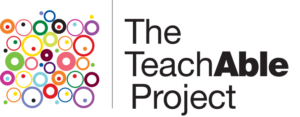Resource
Navigation
Introduction to Accessibility
“In shaping a world where we plan for fairness for everyone, where we appreciate the contributions each individual makes, we are champions of the value that says to all students: ‘What you do is important, how you feel is important. You belong.’ As an educator you have an incredible opportunity to help create this kind of world; you develop understanding among all your students of what accessibility means and how it affects fairness and equity in the opportunities available to people across the entire spectrum of abilities.”
These words sum up the spirit of accessibility legislation and inspire everyone who works with children and youth to be a part of creating a society where every individual has room to succeed.
The Accessibility Awareness Continuum: A Tool for Reflection
The TeachAble Project is founded on the strengths of education teams. Accessibility Awareness, as part of a focus for student learning and staff development, is an important step in building a world of full accessibility.
As a key component of an introductory professional learning module, we have developed the Accessibility Awareness Continuum. This is a tool designed to stimulate reflection and discussion about how accessible your school is, how accessible your classroom is, and how aware your students are of what a fully accessible world means. It can help you clarify:
- your beliefs, attitudes and practices with respect to accessibility issues within your curriculum and teaching, and
- how concepts of accessibility are integrated into your classroom environment and in your students’ voice and values
In its design, the Accessibility Awareness Continuum strongly aligns with the Ontario K-12 School Effectiveness Framework and draws as well on the framework set out in the Equity Continuum: Action for Critical Transformation in Schools and Classrooms developed by the Centre for Urban Schooling at the Ontario Institute for Studies in Education. The topics addressed in the continuum are aligned with accessibility awareness and with Ontario’s priority goals for education.
The Accessibility Awareness Continuum is, first and foremost, a professional learning tool for exploration and building awareness. It offers a way to describe current and desired capacities. It is not intended for evaluative use.
Professional Learning with the Accessibility Awareness Continuum
The Accessibility Awareness Continuum is designed to be used by individuals, by groups of staff organized by grade divisions or subject teams, by departments in secondary schools, by whole school staffs, or, as part of a professional development day in a family of schools. A group approach offers opportunities for rich discussion, collaboration and possible development of accessibility goals, personally, for your classroom, or for your school.
The professional learning experience can focus on one or more aspects of the Accessibility Awareness Continuum. Areas for reflection include
- Advocacy for Change
- Assessment
- Communication
- Classroom Instruction
- Classroom Resources
- Community Connections
- Field Trips, School Events and Special Events
- Learning Climate – Belonging and Relationships
- Transition Pathways
- Student Self-Advocacy
- Technology
Each continuum offers self-reflection questions to help staff identify where their learning environment is on the Accessibility Awareness Continuum and to reflect on changes that are needed, changes they would like to see. Some of these changes may be addressed through suggesting they be included in the School Improvement Plan, through accessing opportunities available through the TeachAble Project Model Lesson Plans, or through tapping into the extensive list of information sources available in the Accessibility+ hub of the TeachAble Project website.
A key goal of the Accessibility for Ontarians with Disabilities Act, 2005 is to make Ontario fully accessible by 2025. This will involve positive change in every aspect of our lives and will significantly affect information and communication, employment, transportation and our built environment. Some changes will be gradual and build on each other. This is why the design of the Accessibility Awareness Continuum suggests improvement that is constantly evolving.
This professional learning tool can help you to identify gaps between what you are doing and what you would like to be doing. It is anticipated that your findings from this reflection will prove to be a motivator to make changes, and develop your personal plan to more effectively model accessibility, inclusivity and equity principles. After taking action and implementing your plan you can, at a later time, redo your self-assessment using the Accessibility Awareness Continuum, see the changes that have occurred and plan your next steps.

![preview_e2c5df19026ac30344a044cf6d1fd0a9[1] Image of Introduction to Accessibility cover](https://theteachableproject.org/wp-content/uploads/2021/09/preview_e2c5df19026ac30344a044cf6d1fd0a91-232x300.jpg)
![preview_a42b9b397ff64b817942538fa3a78782[1] Image of Introduction à l’accessibilité cover](https://theteachableproject.org/wp-content/uploads/2021/09/preview_a42b9b397ff64b817942538fa3a787821-232x300.jpg)